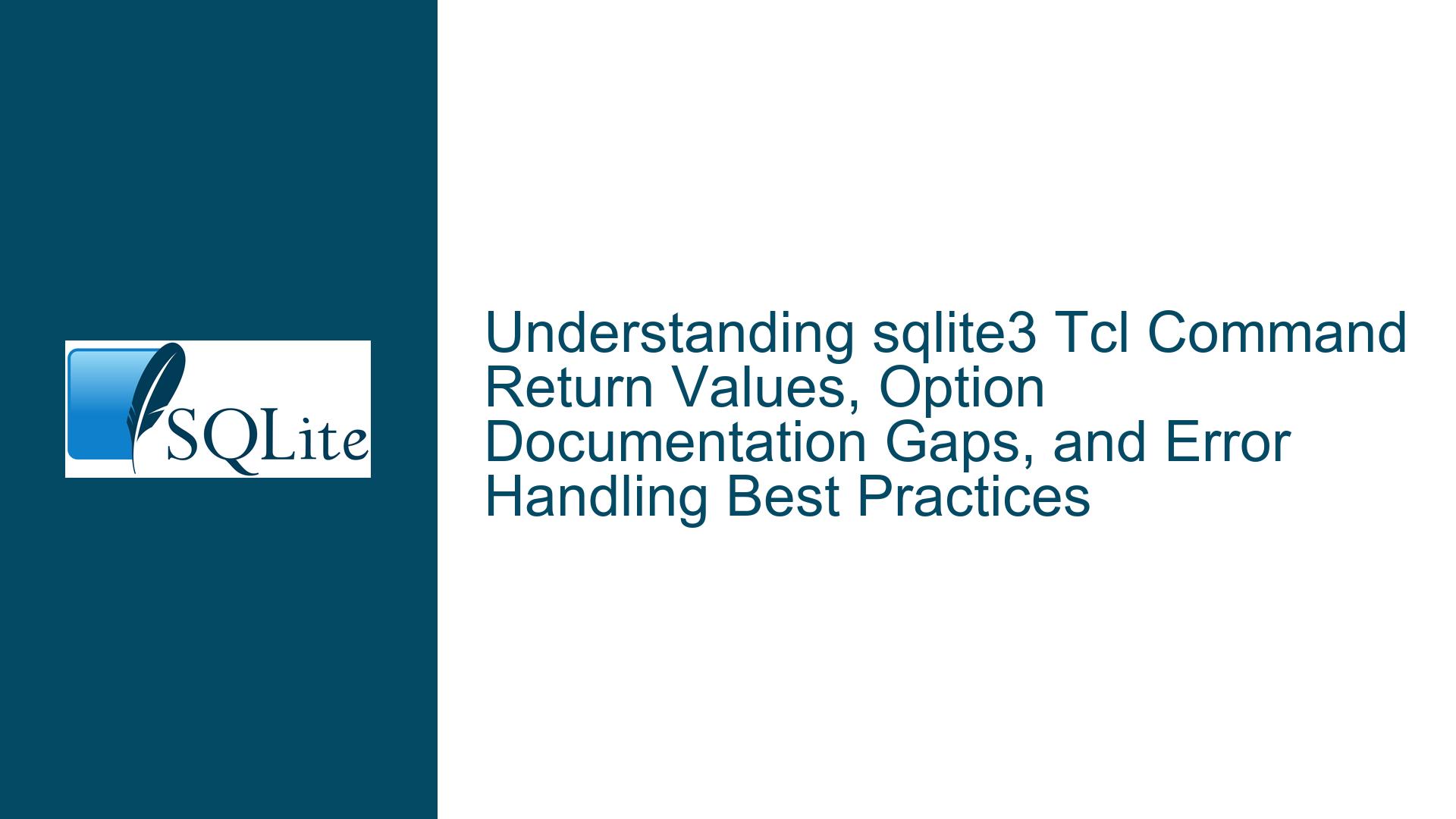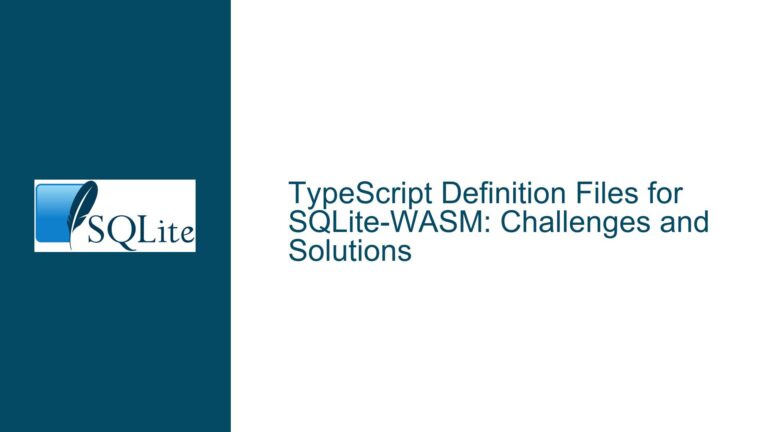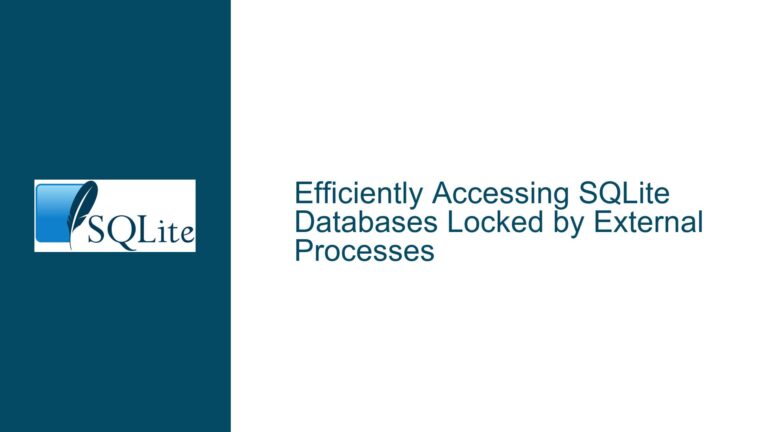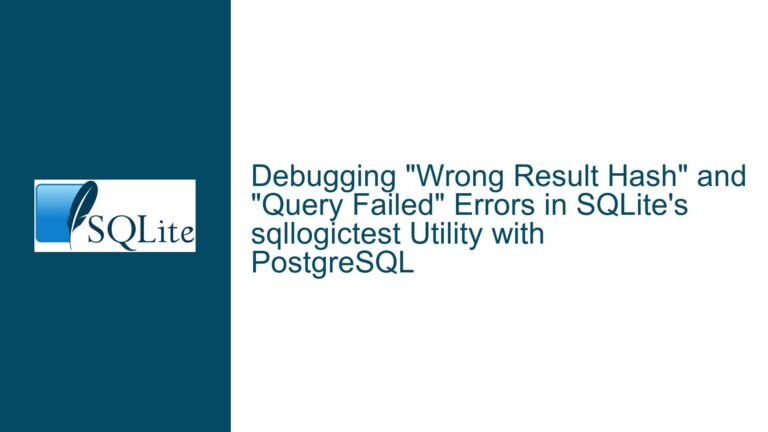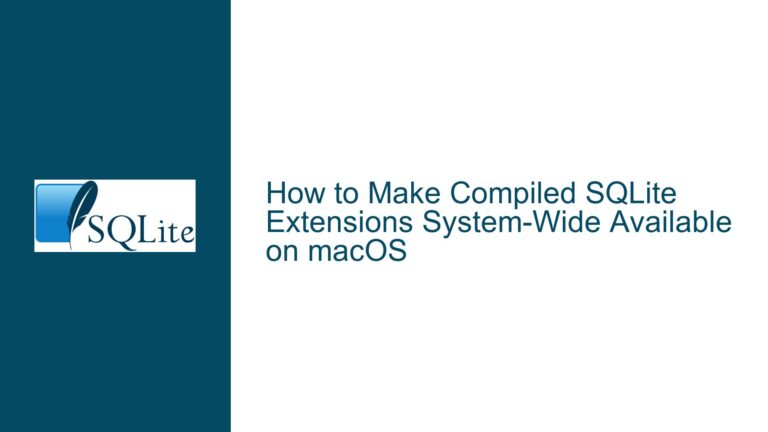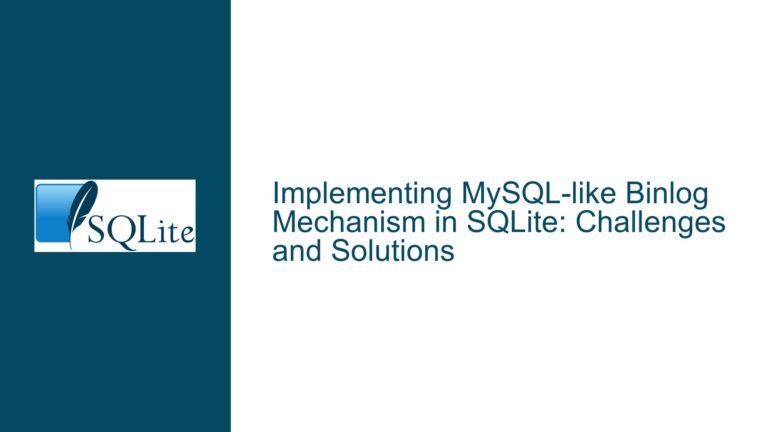sqlite3 Tcl Command Return Values, Option Documentation Gaps, and Error Handling Best Practices
Issue Overview: Ambiguity in sqlite3 Tcl Command Success Indicators and Missing Documentation for Connection Options
The core issues raised in the discussion revolve around three interrelated challenges faced by developers using SQLite’s Tcl interface:
- Unclear return value semantics for the
sqlite3command when opening a database connection. - Discrepancies between documented and actual options supported by the
sqlite3command. - Confusion around modern error handling practices in Tcl, specifically the use of
catchversustryfor trapping errors.
1. Return Value Ambiguity in the sqlite3 Command
The sqlite3 command in Tcl is used to create a database connection. Its syntax is:
sqlite3 dbcmd database-name ?options?
A developer’s primary question concerns what this command returns upon success or failure. Initial observations suggested that:
- On success, the command returns an empty string (
""). - On failure, it returns an error message string.
This behavior is counterintuitive for developers accustomed to explicit return codes (e.g., 0 for success, non-zero for errors). The absence of a clear return value raises questions about how to programmatically verify whether the command succeeded.
2. Undocumented Command-Line Options
When invoking the sqlite3 command with invalid arguments, the error message lists supported options:
-vfs VFSNAME
-readonly BOOLEAN
-create BOOLEAN
-nofollow BOOLEAN
-nomutex BOOLEAN
-fullmutex BOOLEAN
-uri BOOLEAN
However, the official SQLite documentation at the time omitted -nomutex and -fullmutex. This discrepancy creates confusion about which options are valid and whether the documentation is authoritative.
3. Error Handling Paradigms in Tcl
A secondary debate arose around the use of catch versus try for error handling. One contributor incorrectly claimed that catch is deprecated, leading to uncertainty about best practices for trapping errors in Tcl scripts interacting with SQLite.
Root Causes: Tcl Error Propagation Mechanics, Documentation Update Latency, and Evolving Language Features
1. Tcl’s Error Handling Model and the sqlite3 Command
The sqlite3 command follows Tcl’s standard error reporting conventions:
- No explicit return code: Tcl commands typically return data on success and raise an error (via
TCL_ERROR) on failure. - Empty string as success indicator: The
sqlite3command returns""when the database handle is created successfully. This is consistent with Tcl’s design philosophy, where commands returning no meaningful data default to an empty string. - Error strings as side effects: When a command fails, Tcl’s execution engine propagates an error message to the caller, which can be trapped using
catchortry.
The confusion stems from conflating the nominal return value (empty string) with the error state (managed by Tcl’s interpreter). Developers expecting a return code must instead rely on Tcl’s error trapping mechanisms.
2. Documentation vs. Implementation Drift
The missing -nomutex and -fullmutex options in the documentation highlight a common challenge in software maintenance: documentation updates lagging behind code changes. These options control SQLite’s mutex behavior:
-nomutex: Disables mutexes for the connection (not thread-safe).-fullmutex: Enables serialized threading mode (strict thread safety).
These options were likely added to the Tcl interface in a later SQLite release but not documented promptly. Such omissions force developers to reverse-engineer valid options from error messages or source code.
3. Evolution of Tcl Error Handling
The catch command has been a Tcl staple since its early versions. The try command, introduced in Tcl 8.6, offers structured exception handling but is not a deprecation of catch. Misunderstandings arise from:
- Legacy code bias: Older Tcl scripts (pre-8.6) exclusively use
catch, creating a perception thattryis a replacement. - Syntax differences:
tryprovides finer-grained control over error types but requires familiarity with its syntax.
Resolving Ambiguities: Robust Error Checking, Documentation Synchronization, and Modern Error Handling
1. Properly Detecting sqlite3 Command Success
To unambiguously determine whether the sqlite3 command succeeded:
Use catch with Return Code Checking
if {[catch {sqlite3 db1 "test.db" -nomutex 1} error]} {
puts "Connection failed: $error"
} else {
puts "Connection succeeded"
}
catchreturn value:1if an error occurred,0otherwise.- Error message: Stored in the variable
erroron failure.
Avoid Reliance on Nominal Return Value
Testing for an empty string is not reliable, as some Tcl commands return data on success. Always use catch or try to check for errors.
2. Validating and Using Connection Options
Cross-Referencing Documentation and Source Code
- Consult the latest SQLite documentation for updates.
- Review the Tcl interface source code to verify supported options.
Valid Options as of SQLite 3.42.0
| Option | Purpose |
|---|---|
-vfs | Specify a custom VFS |
-readonly | Open database in read-only mode |
-create | Create database if it doesn’t exist |
-nofollow | Disable symlink resolution |
-nomutex | Disable mutexes (non-thread-safe) |
-fullmutex | Enable serialized threading mode |
-uri | Treat filename as a URI |
3. Modern Error Handling with try (Tcl 8.6+)
For Tcl 8.6 or later, use try for cleaner error handling:
try {
sqlite3 db1 "test.db" -invalid_option
} on error {err} {
puts "Error: $err"
}
Advantages Over catch
- Structured error trapping: Separate blocks for success, specific errors, and cleanup.
- Clarity: Explicit handling of return codes vs. errors.
Backward Compatibility with catch
For scripts targeting Tcl 8.5 or earlier, continue using catch:
if {[catch {
sqlite3 db1 "test.db"
} error]} {
# Handle error
}
4. Updating Local Documentation
If discrepancies persist:
- Check the SQLite documentation’s changelog for updates.
- File an issue or pull request on the SQLite documentation repository.
- Use the
-nomutexand-fullmutexoptions with caution, understanding their threading implications.
By addressing these areas systematically, developers can eliminate ambiguity in SQLite’s Tcl interface, ensure correct error handling, and maintain alignment with the latest documentation updates.
